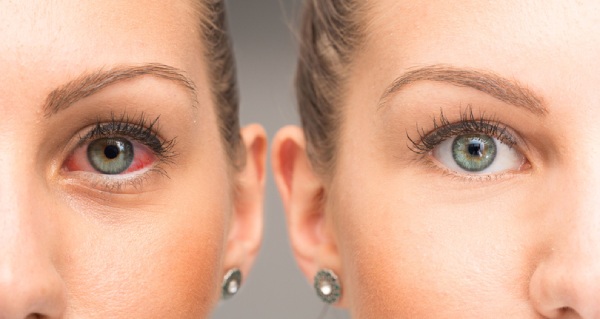Have you ever woken up with the uncomfortable sensation of itchy, red eyes, feeling as if every blink grates like sandpaper?
This could be more than just a rough morning; it might be the onset of pink eye, also known as conjunctivitis.
Recognizing early stage pink eye symptoms is crucial for adults and kids alike. Timely intervention can significantly ease discomfort and prevent the spread of this common yet bothersome condition.
In this comprehensive guide, we’ll explore everything from symptoms to treatments, ensuring you’re equipped with the knowledge to tackle pink eye head-on.
Let’s dive into understanding the early signs and effective management strategies for this eye condition.
What Is Pink Eye (Conjunctivitis)?
Conjunctivitis, widely known as pink eye, is an inflammation or infection of the transparent membrane (conjunctiva) that lines your eyelid and covers the white part of your eyeball.
When small blood vessels in the conjunctiva become inflamed, they’re more visible, making the whites of your eyes appear reddish or pink.
The National Eye Institute states that common symptoms can include itchiness, redness, discharge that forms a crust during the night, and a gritty feeling in the eye, but they can also include swollen eyelids, blurry vision, or sensitivity to light.
This condition affects both adults and children and can result from various causes, including viruses, bacteria, allergens, and more.
Early Stage Pink Eye Symptoms In Adults
In adults, early stage pink eye symptoms often manifest as a red or pink appearance in one or both eyes, accompanied by increased tear production and a gritty sensation as if something is in the eye.
Adults may also experience sensitivity to light, itching, and a discharge that can be either clear or yellow, depending on the cause.
Recognizing these symptoms early can lead to prompt treatment, reducing the risk of spreading the infection to others.

Early Stage Pink Eye Symptoms In Kids
Children, particularly toddlers and those in school, are highly susceptible to pink eye due to their close contact with others and less consistent hygiene practices.
Early signs in kids include redness in one or both eyes, itching or discomfort, and a noticeable discharge that might cause the eyelids to stick together after sleeping.
Kids might also report a feeling of sand in their eyes and be more sensitive to light.
Early detection and treatment in kids are vital to prevent discomfort and minimize the spread within schools or daycare centers.
What Causes Pink Eye? 5 Common Factors
Pink eye can be triggered by various factors, and understanding these causes is crucial for effective treatment and prevention. Here are the five common factors that can lead to pink eye:
1. Viruses
The most prevalent cause of pink eye is viral infections, particularly those associated with the common cold or upper respiratory infections.
Viral conjunctivitis is highly contagious and can spread rapidly in communities, schools, and workplaces.
As explained by the Canadian Association of Optometrists, this type of pink eye often accompanies symptoms like a sore throat, fever, and runny nose.
The adenovirus is a common culprit, but other viruses, including herpes simplex virus, varicella-zoster virus, and the virus causing COVID-19, can also lead to viral conjunctivitis.
2. Bacteria
Bacterial conjunctivitis is another significant cause, resulting from infection by bacteria such as Staphylococcus aureus, Haemophilus influenzae, Streptococcus pneumoniae, and Moraxella catarrhalis.
This type of pink eye can produce more pronounced symptoms, including a thick, yellow-green discharge that may cause the eyelids to stick together, especially after sleep.
3. Allergens
Allergic conjunctivitis occurs when the eyes react to allergens such as pollen, dust mites, pet dander, or molds.
Unlike viral or bacterial conjunctivitis, allergic conjunctivitis is not contagious. It can cause symptoms including itching, redness, watering, and swelling of the eyes.
Seasonal allergies are a common trigger, leading to seasonal allergic conjunctivitis.
4. STI
Sexually Transmitted Infections (STIs) can also cause conjunctivitis, with the Canadian Association of Optometrists stating that gonorrhea and chlamydia are the most common.
This form can be particularly severe and may lead to serious eye damage if not treated promptly.
Newborns can contract this type of conjunctivitis during childbirth if the mother is infected with gonorrhea or chlamydia, leading to neonatal conjunctivitis.
5. Autoimmune Disease
Certain autoimmune diseases, where the body’s immune system mistakenly attacks its own tissues, can lead to pink eye.
Rheumatoid arthritis, lupus, and Sjögren’s syndrome are examples of autoimmune conditions that may cause conjunctivitis as part of their wide range of symptoms.
This type of conjunctivitis may present with less common symptoms, such as dry eyes, pain, and light sensitivity.
Understanding the underlying cause of pink eye is essential for determining the most effective treatment strategy and preventing its spread.
If you suspect you or someone close to you has pink eye, it’s important to seek medical advice to confirm the diagnosis and begin appropriate treatment.

Is Pink Eye Contagious?
One of the most pressing questions surrounding conjunctivitis, or pink eye, is its contagiousness.
The straightforward answer is yes, pink eye can be highly contagious, but the degree and duration of its contagiousness largely depend on the underlying cause.
How Long Is Pink Eye Contagious?
Viral and bacterial forms of pink eye are the most contagious.
They can easily spread from person to person through direct contact with the infected individual’s eye secretions or through objects and surfaces contaminated with these secretions.
For instance, sharing towels, bed linens, cosmetics, or eye drops with someone who has pink eye can transmit the infection.
Viral pink eye can also spread through respiratory droplets when an infected person coughs or sneezes.
The contagious period for viral or bacterial conjunctivitis starts as soon as the symptoms appear and continues until 24-48 hours after starting treatment.
Non-Contagious Forms of Pink Eye
Not all forms of pink eye are contagious. Allergic conjunctivitis, for example, cannot be spread from person to person.
Similarly, conjunctivitis caused by irritants or autoimmune diseases is not contagious.
How Pink Eye Can Be Spread?
Understanding how pink eye can be spread is crucial for preventing its transmission and managing outbreaks, especially in close-knit communities such as schools, families, and workplaces.
The mechanisms of transmission can vary based on the type of conjunctivitis—viral, bacterial, or allergic—but the primary modes involve direct contact with infected secretions or contaminated objects.
Direct Contact with The Infection
The most common way pink eye spreads is through direct contact with the eye secretions of someone who is infected. This can happen in several ways:
- Touching the infected eye and then touching another person’s eye can transmit the infection directly.
- Sharing personal items like makeup, face towels, or pillowcases with someone who has pink eye can lead to transmission. Even items that come into indirect contact with the eye area, such as makeup brushes or eyeglass frames, can harbour the virus or bacteria.
Spread Through Respiratory Droplets
Viral conjunctivitis, in particular, can also spread through respiratory droplets when an infected person coughs or sneezes.
These droplets can carry the virus over short distances and land on the eyes, nose, or mouth of individuals nearby, leading to infection.
This mode of transmission is similar to how the common cold or flu spreads.
Contaminated Surfaces
Objects and surfaces that come into contact with infected secretions can become contaminated and serve as vehicles for spreading pink eye. This includes:
- Door handles, light switches, and shared electronics that are touched by many people throughout the day can become contaminated and facilitate the spread of the infection.
- Bathroom fixtures and kitchen utensils in shared or public spaces can also harbour the virus or bacteria if touched by an infected person.
Pink Eye Prevention – 5 Tips To Prevent Spreading The Infection
Given its highly contagious nature, with the Optometrists Network stating that 1 in 300 people suffer from eye infections each year, taking steps to prevent the spread of pink eye is crucial, especially in communal settings like schools, workplaces, and homes.
Here are some effective measures:
- Frequent Hand Washing: Regularly wash your hands with soap and water for at least 20 seconds, especially after touching your eyes or face, or after contact with someone who has pink eye.
- Avoid Touching Your Eyes: Try not to touch or rub your eyes, as this can spread the infection.
- Personal Items: Do not share personal items such as towels, washcloths, eye cosmetics, or eyeglasses.
- Keep Your Eyes Clean: For those infected, it is key to wash any discharge from your eyes several times a day using a fresh cotton ball or paper towel.
- Clean Surfaces: Regularly disinfect surfaces that are frequently touched, such as doorknobs, countertops, and faucet handles.
Understanding the contagiousness of pink eye and practicing good hygiene are key to controlling its spread.
If you suspect you have pink eye, especially if it could be viral or bacterial, it’s important to seek medical advice promptly.
A healthcare provider can offer guidance on treatment and prevention measures to protect both yourself and those around you from this uncomfortable and highly contagious condition.

Pink Eye Treatment – 5 Common Treatments
How Pink Eye Caused by Viruses Can Be Treated?
Viral conjunctivitis usually resolves on its own within a few weeks without specific treatment. Supportive care, such as applying a cold washcloth to the eyes, can help alleviate symptoms.
How Pink Eye Caused by Bacteria Can Be Treated?
Bacterial conjunctivitis requires antibiotic eye drops or ointments, such as Sandoz Moxifloxacin, or Besivance, to eliminate the infection.
How Pink Eye Caused by Allergies Can Be Treated?
Allergic conjunctivitis is treated with allergy medications and avoiding known allergens. Eye drops to control inflammation and relieve symptoms may also be recommended.
How Pink Eye Caused by Autoimmune Disease Can Be Treated?
Treatment involves addressing the underlying autoimmune condition with the appropriate medications and supportive eye care. Corticosteroid eye drops may be prescribed to reduce inflammation.
How Pink Eye Caused by STIs Can Be Treated?
STI-related conjunctivitis requires treating the underlying sexually transmitted infection with systemic antibiotics. It’s crucial to treat both the STI and the conjunctivitis it causes.
Pink Eye Diagnosis – How Your Healthcare Provider Can Diagnose You
Diagnosis typically involves reviewing symptoms and examining the eyes physically. In some cases, a swab of the conjunctiva may be taken to identify the cause.
An acuity test (eye chart test) might also be performed to check if vision has been affected.
When Can I Visit My Doctor & What Questions To Ask
Visit your doctor if you or your child experience symptoms of pink eye, especially if they persist for more than a week or are accompanied by severe pain, vision problems, or sensitivity to light. Questions to ask include:
- How do I use my prescription medication correctly?
- How can I relieve my pink eye symptoms at home?
- How can I keep the pink eye from spreading to family or friends?

Banish The Discomfort of Pink Eye – Talk to Your Local PharmaChoice Pharmacist
Understanding and recognizing the early stage pink eye symptoms can significantly aid in managing this condition effectively.
At PharmaChoice, we’re committed to providing you with the best care and treatment options for pink eye and other health concerns.
If you or a loved one is experiencing symptoms of pink eye, don’t hesitate to visit your closest PharmaChoice pharmacy.
Our healthcare providers are here to offer expert advice, support, and the right medications to help you recover quickly and comfortably.
Remember, early intervention is key to preventing the spread of pink eye and ensuring a swift recovery.



